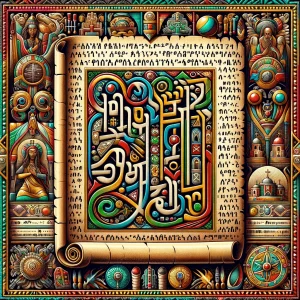Comparing Biblical Canons: Ethiopian Bible vs. King James Version (KJV)


**Historical and Linguistic Context:**
– **Ethiopian Bible**: The scripture of the Ethiopian Orthodox Tewahedo Church includes 81 books, rooted in early Christian traditions of Northeast Africa. This Bible, preserved in the ancient Ge’ez language, includes several books not found in other Christian canons, such as the Book of Enoch, Jubilees, and the Book of Baruch.
– **King James Version (KJV)**: Commissioned in 1604 and published in 1611 by the Church of England, the KJV was an effort to establish an authoritative English translation, employing earlier sources like the Bishops’ Bible and incorporating texts in Hebrew and Greek.
**Translation Philosophy and Techniques:**
– **Ethiopian Bible**: Features early texts translated directly into Ge’ez, reflecting an isolated development of Christianity, preserving many early Christian texts that were omitted or lost in other traditions.
– **King James Version**: Utilizes formal equivalence, aiming for a word-for-word translation that also captures the poetic and liturgical dignity appropriate for English audiences of the time.
### Evolution of Scriptures Across Different Traditions
**1. Hebrew Bible vs. Septuagint:**
– **Variations**: The Septuagint includes books and passages not present in the Hebrew Bible, such as the Wisdom of Solomon. The translation of terms like “almah” to “parthenos” in prophetic texts illustrates shifts in interpretation significant for Christian doctrinal development.
**2. Vulgate vs. Textus Receptus:**
– **Variations**: Differences in source texts and doctrinal emphasis, like the inclusion of the Comma Johanneum in the Textus Receptus, highlight variations that can influence theological perspectives across Christian denominations.
**3. King James Version (KJV) vs. New International Version (NIV):**
– **Variations**: The NIV incorporates modern linguistic and textual scholarship to provide clearer translations of ancient texts, addressing both prose and poetic forms more distinctly than the KJV, reflecting changes in language and interpretative understanding over time.
**4. Ethiopian Bible vs. Eastern Orthodox Bible:**
– **Variations**: The Ethiopian canon includes texts like Enoch and Jubilees, significant for understanding the broader spectrum of early Christian literature and theology, which are not considered canonical in the Eastern Orthodox tradition.
### Summary and Theological Implications
The various canonical and translation differences across Christian traditions not only affect the theological understanding and liturgical practices of their adherents but also highlight the rich diversity within Christianity. These differences underscore the importance of considering historical contexts, translation methodologies, and canonical choices when engaging with biblical texts. This comprehensive perspective helps in appreciating how each tradition has preserved and interpreted its sacred scriptures, contributing to the global mosaic of Christian faith and practice.

